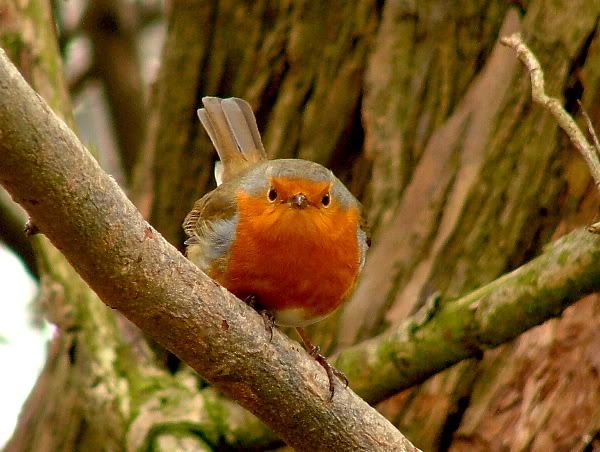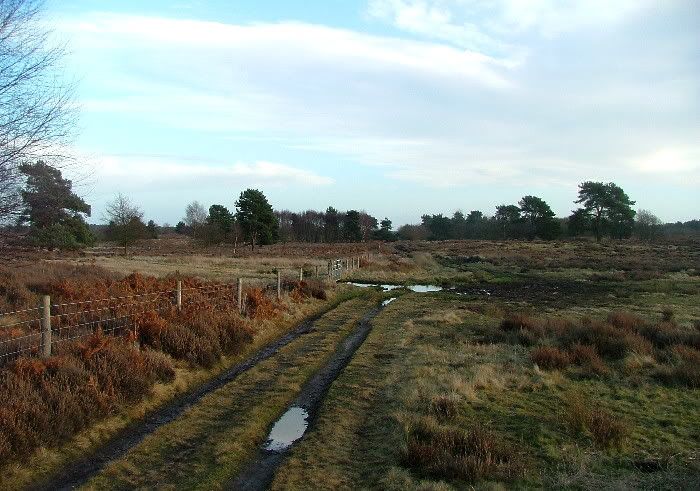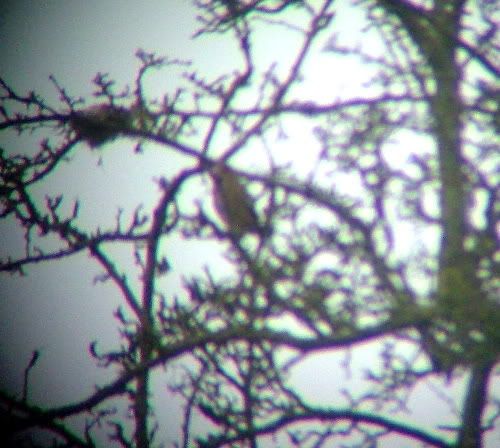Friday 25 January 2008
BGBW Reminder
Just a reminder to everybody that this weekend (26th-27th Jan) is the RSPB's Big Garden Birdwatch - your chance to participate in the huge national bird census the conservation charity organises annually. Check out the website for more - an hour is all it takes and time spent enjoying the undervalued wildlife we all have out there the other side of the kitchen window, all of it contributing to the RSPB's understanding of the influences affecting bird populations.
I'll post my results on Monday.
In other news, my birding activities have taken a backseat to the house-hunt for now. As a reward for last weekend's endeavours the girlfriend gave me 30 minutes at the Ogston Reservoir gull roost. Time well spent as one of those lovely mottled marble 1st-winter Glaucous Gulls (like this one) settled in the ranks.
He'll be an inland wanderer spending the winter feeding at local rubbish dumps, and hatched last year probably somewhere in Greenland. Isn't it wonderful what faraway birds turn up Britain?
Interestingly, a chap told me the Iceland Gull I saw on the 1st of the month, is potentially a Kumlien's Gull, the Canadian subspecies and a much rarer vagrant to Britain (1 or 2 per year in my region). The ID differences are small (these gulls have faint markings on their wingtips rather than pure white), and it's a fine judgment I couldn't make for myself with adequate confidence. The reappraisal came from club members at Ogston.
For me, perhaps it's bad birding to dismiss worries over the exact identification but I can live by just letting these things go from time to time. Among all the regular gulls, it sure was a shimmering stunner.
Labels:
bgbw,
big garden birdwatch,
birding,
Derbyshire,
garden,
glaucous gull,
iceland gull,
Ogston,
RSPB
Friday 11 January 2008
Is Birding Bad for the Environment?
Here's an interesting article from The Times...
A lungful of carbon delusion
Jonathan Leake
How are we to deal with climate change? If you had asked that question 10 years ago the answer would have been simple: plant lots of trees.
If, however, you had asked that same question four years ago you would have been told that nuclear energy and wind farms were the solution. More recently still you might have got yet a third set of answers: biofuels, carbon capture and trading.
...continued
Give it a chance as it goes on to explain the fashionable five minute answers to climate change, carbon sequestration, nuclear energy, etc, for the fallacies they are. It also has harsh words for conservation groups, indeed it mentions the RSPB by name, and I'm vexed because its criticisms are entirely valid. The society does encourage car travel, its magazine is dependably full of advertisements for long-haul birdwatching holidays, while inside in the news pages the dangers of climate change could form an omnipresent headline.
Closer to home I think about all the birdwatchers I know. Most weekends they will be travelling by car, often to sites flung across all regions of the UK, and I begin to wonder, is birdwatching as an activity really such good news for wildlife conservation? We commonly use private transport far more than people who could scarcely give a damn about wildlife, the of which irony sticks out like a saw thumb, and a particularly unwelcome saw thumb at that.
It is abundantly clear to most of us now that carbon emissions influenced climate change has to be the greatest concern for all conservationists. Saving those coastal lagoons today may mean very little when the sea has claimed them in 50 years time, rainforests in South America are already suffering severe drought as weather patterns change, we know the list of conservation projects imperilled by climate change has the potential to be endless. This is why in certain quarters expeditions like The Biggest Twitch can receive such unquiet derision. During 2008 a former RSPB warden plus partner shall fly all over the globe, carbon footprint and all, hoping to break the record for number of species seen in a calendar year, and they do this in the name raising 'awareness' for conservation issues (that bang you just heard was your jaw dropping on your desk).
Clearly we're not all quite as deluded as the Biggest Twitchers, and yet, so many of us will think nothing of regularly driving 50 miles to see some admittedly charming birdlife. With a million RSPB members, maybe 3 million more people birdwatching every year, this all adds up. Fearing that they are a growing influence on carbon emissions and climate change George Monbiot uses the term 'love miles' to describe the flights and car journeys we undertake to see friends and relatives . In a similar capacity, the phrase ethical birdwatchers may need to begin thinking about is 'bird miles'.
Surely this makes it time to reined in our bird miles, and enjoy our local birds for the beautiful natural heritage they are. What is the other option? To continue down the path we're on, encouraging mass transit to top bird sites, ultimately beckoning closer potential oblivion for simply countless numbers of species in the UK and around the world.
'Bird miles' may be a drop in the ocean, infinitesimally insignificant in the face of India's new model car or China's new model coal-fired power stations. But where do we make a stand? There could be no more idea place to begin that with our choice of leisure, should we find it pollutes beyond reason, even if that includes birding. This does not mean the end birding, we all still have kitchen windows.
This month the RSPB heavily promotes the Big Garden Birdwatch, a great exercise indeed. It campaigns to save the albatross, the Sumatran rainforest, the Aquatic Warbler in Poland and fights the expansion of Lydd airport.
Is it time for the RSPB to begin encouraging away from our cars, to make more of our local areas, dare I say, limit our travel?
I can hardly imagine a message members would want to hear less. What to do folks?
Closer to home I think about all the birdwatchers I know. Most weekends they will be travelling by car, often to sites flung across all regions of the UK, and I begin to wonder, is birdwatching as an activity really such good news for wildlife conservation? We commonly use private transport far more than people who could scarcely give a damn about wildlife, the of which irony sticks out like a saw thumb, and a particularly unwelcome saw thumb at that.
It is abundantly clear to most of us now that carbon emissions influenced climate change has to be the greatest concern for all conservationists. Saving those coastal lagoons today may mean very little when the sea has claimed them in 50 years time, rainforests in South America are already suffering severe drought as weather patterns change, we know the list of conservation projects imperilled by climate change has the potential to be endless. This is why in certain quarters expeditions like The Biggest Twitch can receive such unquiet derision. During 2008 a former RSPB warden plus partner shall fly all over the globe, carbon footprint and all, hoping to break the record for number of species seen in a calendar year, and they do this in the name raising 'awareness' for conservation issues (that bang you just heard was your jaw dropping on your desk).
Clearly we're not all quite as deluded as the Biggest Twitchers, and yet, so many of us will think nothing of regularly driving 50 miles to see some admittedly charming birdlife. With a million RSPB members, maybe 3 million more people birdwatching every year, this all adds up. Fearing that they are a growing influence on carbon emissions and climate change George Monbiot uses the term 'love miles' to describe the flights and car journeys we undertake to see friends and relatives . In a similar capacity, the phrase ethical birdwatchers may need to begin thinking about is 'bird miles'.
Surely this makes it time to reined in our bird miles, and enjoy our local birds for the beautiful natural heritage they are. What is the other option? To continue down the path we're on, encouraging mass transit to top bird sites, ultimately beckoning closer potential oblivion for simply countless numbers of species in the UK and around the world.
'Bird miles' may be a drop in the ocean, infinitesimally insignificant in the face of India's new model car or China's new model coal-fired power stations. But where do we make a stand? There could be no more idea place to begin that with our choice of leisure, should we find it pollutes beyond reason, even if that includes birding. This does not mean the end birding, we all still have kitchen windows.
This month the RSPB heavily promotes the Big Garden Birdwatch, a great exercise indeed. It campaigns to save the albatross, the Sumatran rainforest, the Aquatic Warbler in Poland and fights the expansion of Lydd airport.
Is it time for the RSPB to begin encouraging away from our cars, to make more of our local areas, dare I say, limit our travel?
I can hardly imagine a message members would want to hear less. What to do folks?
Thursday 10 January 2008
Best of 2007
It occurred to me that I failed to make an end of year appraisal for 2007, so here's a quick best of round-up...
Best birding site visited... difficult to choose, it'd have to be the North Norfolk Coast, and those magical dawn moments of thousands of roosting Knot, thousands more commuting Pink-feet, Shore Lark below the dunes and Barn Owl quartering closer than you'd dare imagine.
Best bird seen... for rarity value, the juvenile Night Heron at Fairbun Ings in July. Rumour has it this may have been the first true wild bird of the species hatched in the UK.
Best bird photograph...
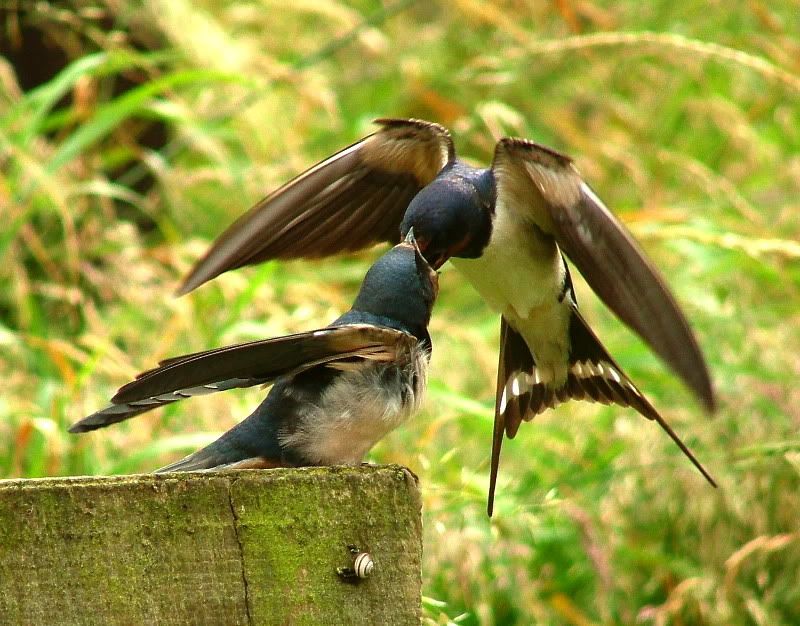
Best birding site visited... difficult to choose, it'd have to be the North Norfolk Coast, and those magical dawn moments of thousands of roosting Knot, thousands more commuting Pink-feet, Shore Lark below the dunes and Barn Owl quartering closer than you'd dare imagine.
Best bird seen... for rarity value, the juvenile Night Heron at Fairbun Ings in July. Rumour has it this may have been the first true wild bird of the species hatched in the UK.
Best bird photograph...

This Swallow fledgling feed at Bempton Cliffs RSPB, also in July.
Best bird video...
Barn Owl at Holkham NNR, late August.
Barn Owl at Holkham NNR, late August.
Best local find... not a classic year, but a pair of Whinchat at Brierley Forest Park stirred interest in the place during April. They would probably breed were it not for the dogwalkers. According to BirdTrack these were earliest birds reported in my region for the year.
Best memories... too many to mention, a shortlist list would include the Starling roost near Carsington, wintry days and rare ducks at Hoveringham, Osprey days at Rutland, magical Montagu's Harrier in Lincolnshire, the Nightjars of Sherwood Forest, 3 lifers in one day with Long-tailed Skua/Sabine's Gull/Red-necked Grebe, picking up a stranded Little Auk at Snettisham, and really I could go on and on.
Best decision... getting involved with the RSPB, volunteering at their Aren't Birds Brilliant(!) events at Carsington Water in Derbyshire, where I educate the public about the RSPB, conservation and birds in general. A genuinely worthy cause, I get to watch and talk about birds all day long, and it's a great crew down there too. That moment when you see it click within a kid, the gasp and dazzle of discovery when they realise how amazing the birdlife is out there, it'll never get old.
The numbers:
190 species on the year list
18 lifers
For the foreseeable future my prediction is 2007 will be my best year for sheer numbers of birds seen. Between moving house, rising petrol prices, and the intention of greenifying my birdwatching activities, I should be cutting back on the travel for 2008/9.
Best memories... too many to mention, a shortlist list would include the Starling roost near Carsington, wintry days and rare ducks at Hoveringham, Osprey days at Rutland, magical Montagu's Harrier in Lincolnshire, the Nightjars of Sherwood Forest, 3 lifers in one day with Long-tailed Skua/Sabine's Gull/Red-necked Grebe, picking up a stranded Little Auk at Snettisham, and really I could go on and on.
Best decision... getting involved with the RSPB, volunteering at their Aren't Birds Brilliant(!) events at Carsington Water in Derbyshire, where I educate the public about the RSPB, conservation and birds in general. A genuinely worthy cause, I get to watch and talk about birds all day long, and it's a great crew down there too. That moment when you see it click within a kid, the gasp and dazzle of discovery when they realise how amazing the birdlife is out there, it'll never get old.
The numbers:
190 species on the year list
18 lifers
For the foreseeable future my prediction is 2007 will be my best year for sheer numbers of birds seen. Between moving house, rising petrol prices, and the intention of greenifying my birdwatching activities, I should be cutting back on the travel for 2008/9.
Labels:
2007,
Aren't Birds Brilliant,
barn owl,
best of,
best of 2007,
bird list,
birdwatching,
carsington,
Derbyshire,
list,
Norfolk,
swallow,
year list
Wednesday 9 January 2008
Old Green Eyes
The sound of happy visitors!
The Carsington Aren't Birds Brilliant events continue their success, and I was on duty twice this week.
We had some pleasant weekend winter sunshine on the Sunday and how the crowds flocked in. Somewhere in the region of 600! Plenty of adults and delightfully plenty of kids too, several very eager to use our scopes. The technique I've developed is to encourage the children to describe the bird they're viewing so that I might identify the species. 'It's a big goose like bird, lots of black on its head and neck, and a bit of white on its face', that sort of procedure. They're usually very good at it, and happy to be told so!
Tuesday was quieter due to the horrendous weather and the onset of the new school term. Walkers and a handful of caravan enthusiasts made up the visitor numbers, both arriving at the centre for the indoor heating more than the birds, but I'll wager they were warmed by both.
As for the birdlife, the Great Northern Diver is still an enigmatic and elusive presence, while the regular Peregrine sets pulses racing. We're low on waders with odd Redshanks joining the skittish flock of 200-300 Lapwing. The treat of the week was the very quiet afternoon when we volunteers were able to scoot down the opposite reaches of the reservoir to view a pair of roosting Tawny Owls. Talk about childlike excitement, I found myself saying, "I saw it blink!". Oh you really can't beat a good view of a true wild owl.
The girlfriend shot the above video at the end of Sunday's event. We'd lately had a conversation over whether any of the British species of birds are ugly, and I confess, I nominated the Cormorant. That prehistoric appearance they have, they're closer to be to dinosaurs than Blue Tits, as if evolution scarcely finished the job on these birds. Sure the green shine of their plumage can be attractive in good light, but really, where was nature's artistic flair? With that said they are fascinating birds, skilled hunters of fish that will coordinate in teams of a dozen or more, and their always entertaining, if clumsy, courtship dance owes something to David Brent
Do they devastate fish numbers on inland waters? Sometimes, in isolated cases, but not at all often. Ask a fisherman and they will tell you Cormorant eat 1 kilo of fish per day, ask a birdwatcher and their answer will be half that. The truth? It probably lies somewhere in between. Therein begins an argument any conservationist would be brave to venture into. Instead, here's another marvellous Youtube video, this time we're watching the famous Li River fishermen, who've found a mutually agreeable coexistence with their Cormorants. Beautiful stuff.
Back at Carsington, in front of the Wildlife Centre Mallards were mating, while Coots built a nest and fiercely defending a territory. Roll on spring, the birds are ready!
Labels:
abb,
Aren't Birds Brilliant,
birdwatching,
carsington,
Cormorant,
Derbyshire,
tawny owl,
volunteering
Saturday 5 January 2008
Shrike One!
Another successful local rarity tracked down today. Budby Common, an area of sandy heathland immediately north of Sherwood Forest Country Park NNR, has been a traditional site for Great Grey Shrike for years now. This winter has been no different, with at least one being reported since early December. It can go up to a week without apparently being seen, but you can generally be sure there's a shrike out there.
A short walk from Budby village brought us to the heath and almost immediately the GGS showed up, pearching atop a scattering of several small trees. It had obviously read the ID literature because this bird showed textbook behaviour, standing on guard on the highest, most exposed branches and even hovering before swooping down on prey hidden deep in the heather. It was just a completely different story to the aloof Shrike we saw only very at Ogston Reservoir last winter. Perhaps the close proximity of the road at the Derbyshire site influenced the very shy behaviour of that bird.
Back to Budby, and there's a two bird theory among some of the locals, although I'm not so sure myself. We watched our shrike for about an hour and saw it wander quite widely between the two areas it has most commonly been sighted. This movements makes sense as their winter territories can reach 50 ha, and that's pretty damn big.
Here's another murky digi-video-scope for the birdtrail record. Hey it was windy all right? And it's the middle of winter out there!
For a better video try this delightful YouTube offering of a Great Grey Shrike in Israel dispatching a mouse. These birds are hardly the size of a Song Thrush, but ferocious enough to deal with all kinds of prey, birds up to the size of Fieldfare and mammals as large as Stoats! Just a real marauder of bird species, making the black highwayman's mask very fitting plumage.
In Britain the Great Grey Shrike is strictly a winter and passage visitor, most of ours probably coming from Scandinavia or possibly Russia. Perhaps 50 or so are present in the UK each year, with a tendency to turn up practically anywhere there is suitable habitat - including but not exclusive to heathland, peat bogs, the edges of pine woodland, and coastal dunes. Basically wherever they are, it's a top notch species, always special.
Elsewhere on the common were Jay, Green Woodpecker, Meadow Pipit, Kestrel and in adjoining farmland a Skylark warbled and a Buzzard cried as it sailed into woodland. A birder who walked from the Sherwood direction noted a pair of Stonechat.
Otherwise, Budby Common is best in spring/summer, as during a July afternoon you have better than not chances of see Nightjar, Cuckoo, Woodcock, Woodlark and Tree Pipit (blog entry from last year). If you can give it a day, you could scarcely find a more rewarding site in the whole of the East Midlands, and they have ice cream at Sherwood Country Park visitor centre!
In Britain the Great Grey Shrike is strictly a winter and passage visitor, most of ours probably coming from Scandinavia or possibly Russia. Perhaps 50 or so are present in the UK each year, with a tendency to turn up practically anywhere there is suitable habitat - including but not exclusive to heathland, peat bogs, the edges of pine woodland, and coastal dunes. Basically wherever they are, it's a top notch species, always special.
Elsewhere on the common were Jay, Green Woodpecker, Meadow Pipit, Kestrel and in adjoining farmland a Skylark warbled and a Buzzard cried as it sailed into woodland. A birder who walked from the Sherwood direction noted a pair of Stonechat.
Otherwise, Budby Common is best in spring/summer, as during a July afternoon you have better than not chances of see Nightjar, Cuckoo, Woodcock, Woodlark and Tree Pipit (blog entry from last year). If you can give it a day, you could scarcely find a more rewarding site in the whole of the East Midlands, and they have ice cream at Sherwood Country Park visitor centre!
Labels:
birding,
birds,
birdwatching,
Budby Common,
great grey shrike,
Nottinghamshire,
rarities,
Sherwood Forest,
Shrike,
video
Wednesday 2 January 2008
Derbyshire Does It Again
Happy New Year!
It's be grand old start to 2008 for me. With a little local knowledge and the defiant will to ignore a particularly groggy head and get up early on the Bank Holiday, I scored with 2 lifers yesterday.
I should be ashamed posting such a poor picture. I swear, if I take a worse bird photograph all year long I should be very surprised. It's a Hawfinch down by Cromford Canal. That's been a traditional location for this impressive and elusive finch for a number of years now, news which has clearly spread as more than a dozen birders where searching for them on New Years Day. Every one of them, I believe, left having had good views too.
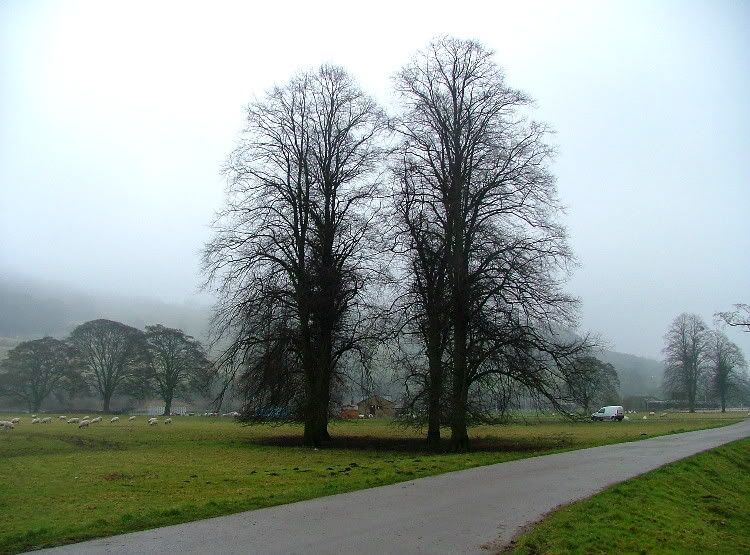
The best spot for them were these tall beech trees nearby the car park, with 3-5 birds staying mainly in the higher branches, though the Hawfinches were occasionally enticed to the ground by the bolder Chaffinches already feeding down there. These sights only occur in winter as you would so well to see Hawfinch come to earth at any other time of the year. Spring, summer and into autumn, they feed high in the canopy and are hidden by foliage.
Overall the conservation status of Hawfinches is very positive in Europe, recent analysis suggesting a boom, indeed an increase of 658% across the continent between 1980 and 2005. Wow!
Yet the news in the UK seems less positive, with a decline in most breeding areas.
The bird itself is unmistakable once you find it, and beyond the obvious - that enormous nutcracking bill, the bulky size and peachy tones, it was the black mask that struck me. There's something almost Dick Whittington about the way it looks.
Elsewhere along the canal, 14 Dabchicks along a couple of miles afforded very close viewing, with one quite bizarrely eager to take the bread visitors were throwing to the ducks. Surely this cannot be healthy for a species evolved to feed on aquatic insects and small fish?
Other bird species along the canal included Jay, Great Spotted Woodpecker, Goldcrest, Nuthatch, Grey Wagtail (around the water treatment works) and Coal Tit. So far as other wildlife goes, Cromford is most famous for Water Vole, and I very clearly remember how easy they were to see chugging along the canal when I was a child. Now in 2008, we only saw a dead one drowned on a steep banked length of the canal (I'll save you the photograph), and I hear that they've dropped in number big time in the last several years. It's very sad for me, because I'm still young and yet I can already say I remember when...
My other lifer of the day was an Iceland Gull at Ogston Reservoir. Again, a traditional site, with upto 15,000 gulls roosting in the winter on those waters, a few of the rarer species are always going to turn up. So with the Black-headed, Lesser and Great Black-backeds, Herrings and Commons, in came a superb 2nd-winter Iceland Gull. A beautiful, largely white bird, with warm brown speckles, gull species just don't get anymore attractive.
A murky video of a gull not from Iceland!
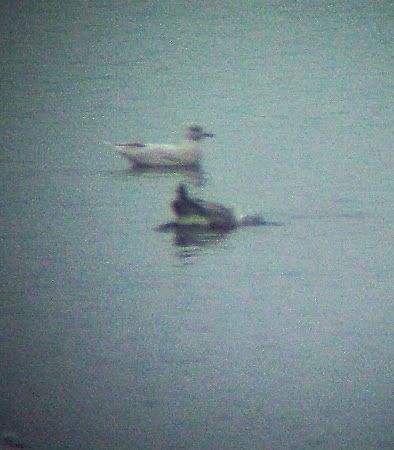 Check out the white wingtips on the bird at the back - always means something a bit special in the UK.
Check out the white wingtips on the bird at the back - always means something a bit special in the UK.
Ironically, Iceland Gulls do not breed in the country that gave them their name. Instead most seen in the UK will originate from Greenland. They rare inland and are most numerous on the coasts of NW Scotland, but a few dozen birds will always turn up on reservoirs in the midlands, just like Ogston.
The girlfriend was tired so we left while more gulls were heading in, apparently Glaucous and Mediterranean Gull arrived later on. However we did see a pair of Pink-footed Geese, associating with the Canadas in the surrounding fields.
So that's two new UK species for me, in one day, within hardly 30 miles of driving. I'm a happy birder!
Video 1 - Dabchick eating bread
It's be grand old start to 2008 for me. With a little local knowledge and the defiant will to ignore a particularly groggy head and get up early on the Bank Holiday, I scored with 2 lifers yesterday.
I should be ashamed posting such a poor picture. I swear, if I take a worse bird photograph all year long I should be very surprised. It's a Hawfinch down by Cromford Canal. That's been a traditional location for this impressive and elusive finch for a number of years now, news which has clearly spread as more than a dozen birders where searching for them on New Years Day. Every one of them, I believe, left having had good views too.

The best spot for them were these tall beech trees nearby the car park, with 3-5 birds staying mainly in the higher branches, though the Hawfinches were occasionally enticed to the ground by the bolder Chaffinches already feeding down there. These sights only occur in winter as you would so well to see Hawfinch come to earth at any other time of the year. Spring, summer and into autumn, they feed high in the canopy and are hidden by foliage.
Overall the conservation status of Hawfinches is very positive in Europe, recent analysis suggesting a boom, indeed an increase of 658% across the continent between 1980 and 2005. Wow!
Yet the news in the UK seems less positive, with a decline in most breeding areas.
The bird itself is unmistakable once you find it, and beyond the obvious - that enormous nutcracking bill, the bulky size and peachy tones, it was the black mask that struck me. There's something almost Dick Whittington about the way it looks.
Elsewhere along the canal, 14 Dabchicks along a couple of miles afforded very close viewing, with one quite bizarrely eager to take the bread visitors were throwing to the ducks. Surely this cannot be healthy for a species evolved to feed on aquatic insects and small fish?
Other bird species along the canal included Jay, Great Spotted Woodpecker, Goldcrest, Nuthatch, Grey Wagtail (around the water treatment works) and Coal Tit. So far as other wildlife goes, Cromford is most famous for Water Vole, and I very clearly remember how easy they were to see chugging along the canal when I was a child. Now in 2008, we only saw a dead one drowned on a steep banked length of the canal (I'll save you the photograph), and I hear that they've dropped in number big time in the last several years. It's very sad for me, because I'm still young and yet I can already say I remember when...
My other lifer of the day was an Iceland Gull at Ogston Reservoir. Again, a traditional site, with upto 15,000 gulls roosting in the winter on those waters, a few of the rarer species are always going to turn up. So with the Black-headed, Lesser and Great Black-backeds, Herrings and Commons, in came a superb 2nd-winter Iceland Gull. A beautiful, largely white bird, with warm brown speckles, gull species just don't get anymore attractive.
A murky video of a gull not from Iceland!
 Check out the white wingtips on the bird at the back - always means something a bit special in the UK.
Check out the white wingtips on the bird at the back - always means something a bit special in the UK.Ironically, Iceland Gulls do not breed in the country that gave them their name. Instead most seen in the UK will originate from Greenland. They rare inland and are most numerous on the coasts of NW Scotland, but a few dozen birds will always turn up on reservoirs in the midlands, just like Ogston.
The girlfriend was tired so we left while more gulls were heading in, apparently Glaucous and Mediterranean Gull arrived later on. However we did see a pair of Pink-footed Geese, associating with the Canadas in the surrounding fields.
So that's two new UK species for me, in one day, within hardly 30 miles of driving. I'm a happy birder!
Video 1 - Dabchick eating bread
Labels:
birding,
birdwatching,
cromford canal,
dabchick,
Derbyshire,
hawfinch,
iceland gull,
little grebe,
local,
Ogston,
rarities
Subscribe to:
Posts (Atom)
